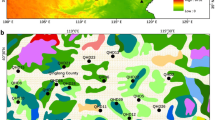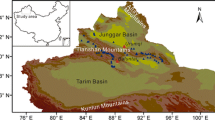Abstract
Thirteen surface moss samples were collected for pollen analysis from an area of heathland in western Norway. Vegetation composition at different distances around the sampling locations was measured using three different survey methods; rooted frequency within a sub-divided 1 m × 1 m quadrat, visual estimates of cover within a 1 m × 1 m quadrat and a modified form of the ‘circle-walking method’. Extended R-value analysis was used to explore the pollen–vegetation relationships for five main taxa, Calluna vulgaris, Vaccinium-type, Cyperaceae, Poaceae and Potentilla-type. The estimates of relevant source area of pollen obtained were similar regardless of the vegetation survey method. Values obtained were always under 4 m. However, estimates of relative pollen productivity and the background pollen component (proportion of pollen coming from vegetation growing beyond the relevant source area of pollen) differ markedly depending on the method of vegetation survey chosen. This has important implications for the quantitative reconstruction of past vegetation cover.








Similar content being viewed by others
References
Andersen ST (1970) The relative pollen productivity and pollen representation of North European trees, and correction factors for tree pollen spectra. Danmarks Geologiske Undersøgelse Række II 96:1–99
Andersen ST (1973) The differential pollen productivity of trees and its significance for the interpretation of pollen diagrams from a forested region. In: Birks HJB, West RG (eds) Quaternary plant ecology. Wiley, Chichester, pp 109–115
Broström A (2002) Estimating source area of pollen and pollen productivity in cultural landscapes of southern Sweden: developing a palynological tool for quantifying past plant cover. Ph.D. thesis, Department of Quaternary Geology, Lund University, Lund
Broström A, Sugita S, Gaillard MJ (2004) Pollen productivity estimates for reconstruction of past vegetation cover in the cultural landscape of Southern Sweden. Holocene 14:371–384
Broström A, Sugita S, Gaillard MJ, Pilesjö P (2005) Estimating spatial scale of pollen dispersal in the cultural landscape of southern Sweden. Holocene 15:1–14
Broström A, Nielsen AB, Gaillard MJ, Hjelle K, Mazier F, Binney H, Bunting J, Fyfe R, Meltsov V, Poska A, Räsänen S, Soepboer W, van Stedingk H, Suutari H, Sugita S (2008) Pollen productivity estimates of key European plant taxa for quantitative reconstruction of past vegetation: a review. Veget Hist Archaeobot 17:461–468
Bunting MJ (2003) Pollen–vegetation relationships in non-arboreal moorland taxa. Rev Palaeobot Palynol 125:285–298
Bunting MJ, Middleton R (2005) Modelling pollen dispersal and deposition using HUMPOL software: simulating wind roses and irregular lakes. Rev Palaeobot Palynol 134:185–196
Bunting MJ, Gaillard MJ, Sugita S, Middleton R, Broström A (2004) Vegetation structure and pollen source area. Holocene 14:651–660
Caseldine C, Fyfe R (2006) A modelling approach to locating and characterising elm decline/landnam landscapes. Q Sci Rev 25:632–644
Davis M (1963) On the theory of pollen analysis. Am J Sci 261:897–912
Davis M (2000) Palynology after Y2K: understanding the source area of pollen in sediments. Ann Rev Earth Planet Sci 28:1–18
Evans AT, Moore PD (1985) Surface pollen studies of Calluna vulgaris (L.) Hull and their relevance to the interpretation of bog and moorland pollen diagrams. Circaea 3:173–178
Fægri K, Iversen J (1989) Textbook of pollen analysis. Wiley, Chichester
Gaillard MJ, Sugita S, Bunting MJ, Middleton R, Broström A, Caseldine C, Giesecke T, Hellman SEV, Hicks S, Hjelle K, Langdon C, Nielsen AB, Poska A, von Stedingk H, Veske S (2008) The use of modelling and simulation approach in reconstructing past landscapes from fossil pollen data: a review and results from the POLLANDCAL network. Veget Hist Archaeobot 17:419–443
Hellman S, Gaillard MJ, Broström A, Sugita S (2008a) The REVEALS model, a new tool to estimate past regional plant abundance from data in large lakes: validation in southern Sweden. J Quat Sci 23:21–42
Hellman S, Brostöm A, Gaillard MJ, Sugita S (2008b) Effects of the sampling design and selection of parameter values on pollen-based quantitative reconstructions of regional vegetation: a case study in southern Sweden using the REVEALS model. Veget Hist Archaeobot 17:445–460
Hellman S, Bunting MJ, Gaillard MJ (2009) Relevant source area of pollen in patchy cultural landscapes and signals of anthropogenic landscape disturbance in the pollen record: a simulation approach. Rev Palaeobot Palynol 153:245–258
Hjelle KL (1998) Herb pollen representation in surface moss samples from mown meadows and pastures in western Norway. Veget Hist Archaeobot 7:79–96
Hjelle KL (1999) Modern pollen assemblages from mown and grazed vegetation types in western Norway. Rev Palaeobot Palynol 107:55–81
Jackson ST (1994) Pollen and spores in quaternary lake sediments as sensors of vegetation composition: theoretical models and empirical evidence. In: Transverse A (ed) Sedimentation of organic particles. Cambridge University Press, Cambridge, pp 253–286
Kvamme M (1982) En vegetasjonshistorisk undersøkelse av kulturlandskapets utvikling på Lurekalven, Lindås hd., Hordaland. [A vegetation historical investigation of the cultural landscape development at Lurekalven, Lindås hd., Hordaland]. Unpublished thesis, University of Bergen
Mazier F, Brostöm A, Gaillard MJ, Sugita S, Vittoz P, Buttler A (2008) Pollen productivity estimates and relevant source area for major taxa in a pasture woodland (Jura mountains, Switzerland). Veget Hist Archaeobot 17:479–496
Nielsen AB, Odgaard BV (2005) Reconstructing land cover from pollen assemblages from small lakes in Denmark. Rev Palaeobot Palynol 133:1–21
Øvstedal DO (1992) Utluro: vegetasjon, flora og fastruter [Utluro: vegetation, flora and permanent plots]. Unpublished manuscript
Pardoe HS (1996) Micro-scale patterns of modern pollen deposition within three alpine plant communities. New Phytol 132:327–341
Parsons RW, Prentice IC (1981) Statistical approaches to R-values and pollen–vegetational relationship. Rev Palaeobot Palynol 32:127–152
Prentice IC (1985) Pollen representation, source area, and basin size: toward a unified theory of pollen analysis. Quat Res 23:76–86
Prentice IC (1988) Records of vegetation in time and space: the principles of pollen analysis. In: Huntley B, Webb T III (eds) Vegetation history. Kluwer, Dordrecht, pp 17–42
Prentice IC, Parsons RW (1983) Maximum likelihood linear calibration of pollen spectra in terms of forest composition. Biometrics 39:1051–1057
Räsänen S, Suutari H, Nielsen AB (2007) A step further towards quantitative reconstruction of past vegetation in Fennoscandian boreal forests: pollen productivity estimates for six dominant taxa. Rev Palaeobot Palynol 146:208–220
Sugita S (1993) A model of pollen source area for an entire lake surface. Quatern Res 39:239–244
Sugita S (1994) Pollen representation of vegetation in quaternary sediments: theory and method in patchy vegetation. J Ecol 82:881–897
Sugita S (2007a) Theory on quantitative reconstruction of vegetation. I. Pollen from large sites REVEALS regional vegetation composition. Holocene 17:229–241
Sugita S (2007b) Theory on quantitative reconstruction of vegetation. II. All you need is LOVE. Holocene 17:243–257
Sugita S, Gaillard MJ, Broström A (1999) Landscape openness and pollen records: a simulation approach. Holocene 9:409–421
Tallis JH (1997) The pollen record of Empetrum nigrum in southern Pennine peats: implications for erosion and climate change. J Ecol 85:455–465
von Stedingk H, Fyfe R, Allard A (2008) Pollen productivity estimates for the reconstruction of past vegetation at the forest tundra ecotone. Holocene 18:323–332
Acknowledgements
This paper is a contribution to the work of the PolLandCal network co-ordinated by Marie-José Gaillard. We would like to thank all members of the network for interesting discussions over the last 6 years, especially Anna Broström for practical demonstrations of field methods, and Shinya Sugita for access to ERV model code (used in PolERV). Anne Birgitte Nielsen and Ralph Fyfe are thanked for valuable comments to the manuscript. Travel to Norway for fieldwork was funded by a Leverhulme Personal Grant (RF&G/2/RFG/2001/0132) to MJB and the research has been supported by the Melzer Foundation, UiB to KLH. Mons Kvamme and Dag Olav Øvstedal gave access to unpublished vegetation maps and Gidske L. Andersen compiled the maps. Lene S. Halvorsen and Ingvild K. Mehl provided cheerful field assistance, Beate Helle assisted with figures and Jan Berge prepared the pollen samples. The paper is dedicated to Sheila Hicks in appreciation of many discussions of pollen production in northern landscapes, and of her sterling example of the scientific and personal value of getting started with small scale empirical study of an interesting research question rather than waiting for full-scale funding.
Author information
Authors and Affiliations
Corresponding author
Additional information
Communicated by T. Giesecke.
Rights and permissions
About this article
Cite this article
Bunting, M.J., Hjelle, K.L. Effect of vegetation data collection strategies on estimates of relevant source area of pollen (RSAP) and relative pollen productivity estimates (relative PPE) for non-arboreal taxa. Veget Hist Archaeobot 19, 365–374 (2010). https://doi.org/10.1007/s00334-010-0246-2
Received:
Accepted:
Published:
Issue Date:
DOI: https://doi.org/10.1007/s00334-010-0246-2




